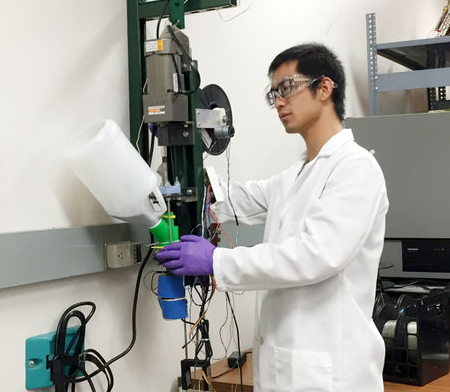Source
- Shan Zhong, Pratiksha Rakhe and Joshua M. Pearce. Energy Payback Time of a Solar Photovoltaic Powered Waste Plastic Recyclebot System. Recycling 2017, 2(2), 10; doi: 10.3390/recycling2020010 open access
Abstract

The growth of both plastic consumption and prosumer 3-D printing are driving an interest in producing 3-D printer filaments from waste plastic. This study quantifies the embodied energy of a vertical DC solar photovoltaic (PV) powered recyclebot based on life cycle energy analysis and compares it to horizontal AC recyclebots, conventional recycling, and the production of a virgin 3-D printer filament. The energy payback time (EPBT) is calculated using the embodied energy of the materials making up the recyclebot itself and is found to be about five days for the extrusion of a poly lactic acid (PLA) filament or 2.5 days for the extrusion of an acrylonitrile butadiene styrene (ABS) filament. A mono-crystalline silicon solar PV system is about 2.6 years alone. However, this can be reduced by over 96% if the solar PV system powers the recyclebot to produce a PLA filament from waste plastic (EPBT is only 0.10 year or about a month). Likewise, if an ABS filament is produced from a recyclebot powered by the solar PV system, the energy saved is 90.6–99.9 MJ/kg and 26.33–29.43 kg of the ABS filament needs to be produced in about half a month for the system to pay for itself. The results clearly show that the solar PV system powered recyclebot is already an excellent way to save energy for sustainable development.
Keywords
energy payback time; distributed manufacturing; life cycle analysis; photovoltaic; recycling; solar energy; recyclebot; 3-D printing; polymer filament; EPBT
See Also
- Recyclebot
- Tightening the loop on the circular economy: Coupled distributed recycling and manufacturing with recyclebot and RepRap 3-D printing
- Life cycle analysis of distributed recycling of post-consumer high density polyethylene for 3-D printing filament
- Evaluation of Potential Fair Trade Standards for an Ethical 3-D Printing Filament
- Mechanical Properties of Components Fabricated with Open-Source 3-D Printers Under Realistic Environmental Conditions
- Mechanical testing of polymer components made with the RepRap 3-D printer
- Development and feasibility of applications for the RepRap 3-D printer
- Life cycle analysis of distributed polymer recycling
- Solar powered distributed customized manufacturing
- Distributed recycling of post-consumer plastic waste in rural areas
- Ethical Filament Foundation
- Wood Furniture Waste-Based Recycled 3-D Printing Filament
- Economist article on U. of Washington's HDPE boat, Oprn3dp.me
- Cruz, F., Lanza, S., Boudaoud, H., Hoppe, S., & Camargo, M. Polymer Recycling and Additive Manufacturing in an Open Source context: Optimization of processes and methods. http://sffsymposium.engr.utexas.edu/sites/default/files/2015/2015-127-Cruz.pdf
Literature Reviews
- Solar powered recyclebot literature review
- Waste plastic extruder: literature review
- Life cycle analysis of polymer recycling literature review





